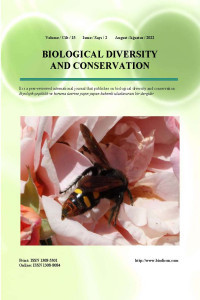Rindera cetineri Yıldırım (Boraginaceae) üzerinde anatomik, mikromorfolojik ve karyolojik araştırmalar
Anatomi, karyoloji, mikromorfoloji, Rindera cetineri
Anatomical, micromorphological and karyological studies on Rindera cetineri Yıldırım (Boraginaceae)
Anatomy, karyology, micromorphology, Rindera cetineri,
___
- [1] Ahmed, A., & Kordofani, M. A. (2012). Morphological and anatomical studies of Cordia abyssinica R. Br. and Cordia sinensis Lam.(Boraginaceae) in Sudan. Journal of Chemical and Pharmaceutical Research, 4(10), 4582–4588.
- [2] Özcan, T., & Süzerer, V. (2020). Variation of some seed oil components at altitidunal range in a widely distributed species, Echium italicum L. (Boraginaceae) from Turkey. Journal of Materials and Environmental Science, 11(4), 540–550.
- [3] Sezer, O. (2021). Onosma onur-koyuncui sp. nov. (Boraginaceae), A new species from Kütahya, Turkey. Pakistan Journal of Botany, 53(4), 1315–1323. http://doi.org/10.30848/PJB2021-4(33)
- [4] Bigazzi, M., Nardi, E., & Selvi, F. (2006). Palynological contribution to the systematics of Rindera and the allied genera Paracaryum and Solenanthus (Boraginaceae-Cynoglosseae). Willdenowia, 36(1), 37–46. https://doi.org/10.3372/wi.36.36103
- [5] Güner, A., Aslan, S., Ekim, T., Vural, M., & Babaç, M. T. (2012). Türkiye Bitkileri Listesi. Damarlı Bitkiler. İstanbul, Türkiye: Nezahat Gökyiğit Botanik Bahçesi ve Flora Araştırmaları Derneği Yayını.
- [6] Yıldırım, H. (2019). A new Rindera (Boraginaceae) species from Western Anatolia, Turkey. Phytotaxa, 427(4), 249–258. https://doi.org/10.11646/phytotaxa.427.4.3
- [7] Mill, R.R. (1979). Rindera. In P.H. Davis (Ed.), Flora of Turkey and the East Aegean Islands VI (pp. 300–303). Edinburgh, UK: Edinburgh University Press.
- [8] Aytaç, Z., & Mill, R. R. (2005). Two new species of Boraginaceae (tribe Cynoglosseae) from Turkey. Edinburgh Journal of Botany, 61(2–3), 109-118. https://doi.org/10.1017/S0960428605000284
- [9] Wodehouse, R.P. (1935). Polen Grains, New York: USA, Mc Graw Hill.
- [10] Levan, A., Fredga, K., & Sandberg, A. A. (1964). Nomenclature for centromeric position on chromosomes. Hereditas, 52(2), 201–220.
- [11] Paszko, B. (2006). A critical review and a new proposal of karyotype asymmetry indices. Plant Systematics and Evolution, 258(1), 39–48. https://doi.org/10.1007/s00606-005-0389-2
- [12] Metcalfe, C. R., & Chalk, L. (1979). Anatomy of the Dicotyledons: Systematic Anatomy of Leaf and Stem, with a brief history of the subject (Vol 1, 2nd Edition, pp. 100–106). Oxford: UK, Clarendon Press.
- [13] Akçin, Ö. E., Altıntaş, M. Y., & Aktaş, T. (2016). Myosotis propinqua (Fisch. et Mey. ex DC.) (Boraginaceae) Türünün Anatomik Özellikleri. Karadeniz Fen Bilimleri Dergisi, 6(13), 44–52.
- [14] Casson, S., & Gray, J. E. (2008). Influence of environmental factors on stomatal development. New Phytologist, 178, 9–23. https://doi.org/10.1111/j.1469-8137.2007.02351.x
- [15] Attar, F., Esfandani‐Bozchaloyi, S., Mirtadzadini, M., Ullah, F., & Zaman, W. (2019). Foliar and stem epidermal anatomy of the tribe Cynoglosseae (Boraginaceae) and their taxonomic significance. Microscopy Research and Technique, 82(6), 786–802. https://doi.org/10.1002/jemt.23223
- [16] Erdtman, G. (1966). Pollen morphology and plant taxonomy. Angiosperms. (An Introduction to Palynology I). New York: USA, Hafner.
- [17] Attar, F., Esfandani-Bozchaloyi, S., Mirtadzadini, M., & Ullah, F. (2018). Taxonomic identification in the tribe Cynoglosseae (Boraginaceae) using palynological characteristics. Flora, 249, 97–110. https://doi.org/10.1016/j.flora.2018.10.003
- [18] Gustavsson, L. A. (1978). Floristic reports from the high mountains of Sterea Ellas, Greece. II. Botaniska Notiser, 131, 201–213.
- [19] Ghaffari, S. M. (1996). Chromosome studies in some species of Boraginaceae from Iran. The Iranian Journal of Botany, 7(1), 81–93.
- [20] Koyuncu, O., Öztürk, D., Erkara, İ. P., & Kaplan, A. (2008). Anatomical and palynological studies on economically important Peganum harmala L. (Zygophyllaceae). Biological Diversity and Conservation, 1(1), 108–115.
- ISSN: 1308-5301
- Yayın Aralığı: Yılda 3 Sayı
- Başlangıç: 2008
- Yayıncı: Ersin YÜCEL
Mert ILHAN, Muhammed Mesud HÜRKUL
Türkiye’nin tatlısu alg florası için yeni kayıtlar
Gülşen KARAÇOBAN, Gürkan SEMİZ, Esra MARTİN
Susuz lahana turşusundan izole edilen laktik asit bakterilerinin probiyotik potansiyeli
Miray Gizem BİNGÖL, İlkin ŞENGÜN
Mehmet Gökhan HALICI, Alan FRYDAY, Merve KAHRAMAN YİĞİT, Feyza Nur AVCI
Kayıp kent Halfeti’nin bir başka saklı bitkisi: Yeşil gül
Ömer EYÜBOĞLU, Huri EYUBOGLU, Fulden EYÜBOĞLU
Anadolu’nun farklı bitkilerinden geleneksel pekmez üretimi ve etnobotanik özellikleri
Kahramanmaraş İlinin Kurbağa ve Sürüngen Çeşitliliği
Deniz YALÇINKAYA, Mehmet Zülfü YILDIZ, Eda SAMİ, Mehmet Akif BOZKURT, Fatma ÜÇEŞ, Abdullah ÖZCAN
Sıçan böbrek dokusunda etanolün akut toksisitesi ve borik asitin koruyucu rolü
Tuğçe Gül GÜNEY, Aleyna ÇALIŞKAN, Fatih KAR, Ayşe ÇAKIR GÜNDOĞDU, Cansu ÖZBAYER
